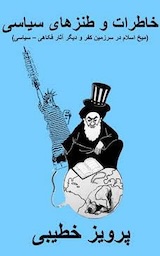[1][2][3-A][3-B][3-C][3-D][3-E][3-F][3-G][3-H][3-I][4-A][4-B][4-C][4-D][4-E][4-F][4-G][4-H][4-I][4-J][4-K][4-L][4-Notes][5-A][5-B][5-C][Bibliography]
Chapter 5-A
Further Developments
1. The Discourse of “The People”
As was already mentioned, after Nimâ wrote a long narrative poem called “The Castle of Soqrim” (Qal‘e-ye Soqrim) in 1934, a lapse of three years would pass before he published his next poem, “Phoenix” (Chicness), in 1937. This is the first poem in which the line length is variable and the rhyme pattern irregular. From then on, Nimâ began to write mostly in this style which sometimes he and others mistakenly termed “free verse” (she‘r‑e âzâd), but which in the last two decades is increasingly referred to by Persian poets and critics as “Nimâian poetry” (she‘r‑e nimâ'i) or “Nimâian metrics” (‘aruz-e nimâ'i).
The man who coined this term was Mehdi Akhavân-Sâles (d. 1994) who used it in his article “A Type of Meter in Poetry.” Akhavân liked to heal the wound between the traditionalists and the modernist followers within the school of Nimâ's poetry. Therefore, in his article, first he tried to show that Nimâ fundamentally has not changed the classical prosody:
Nimâ has not ruined the other meters. He has not deprived us of that 120 meters; rather he has added one type to other types of forms in using the same meters. This is a type which can employ one or more meters within one poem and thus receive the benefits of shifting moods whenever it is needed.
And then Akhavân presents his suggestion:
If naming is necessary, one can call it Nimâian (or free) prosody. . . The word Nimâte can be used because Nimâ is the inventor and the creator of this rational and steady innovation in our ‘aruz (Persian prosody) or one can use the word âzâd (free). However, I prefer using the name of the inventor of this type.
Nimâ published his first “night poem” in 1938, called “Phoenix” and continued to write in this genre during the years which followed. In 1945 he wrote a long narrative poem called “The Bell” (Nâqus) in which, to my knowledge, for the first time he spoke of khalq (the people) extensively and systematically, which gradually extended to his other works and led to a new discourse for him in a Foucaultian sense of the word. He was no longer the voice of the countryside, as was the case in the first period of his work, but rather “the voice of the people” in the leftist sense of the word, that is, the voice of the toiling masses of the city and the countryside marching for a “democratic revolution”. Composed in February of 1945, “The Bell” provides a platform for a new preacher who sells a new gospel. Each part of this long poem begins with the bell's ding-dong, which announces the start of a new part of the sermon. Like his night poems, Nimâ here employs the night-motif as well; however he goes beyond its metaphors and draws a clear-cut party-line for class struggle between the poor people on one side and the rich and the social parasites on the other:
Has the peasant's shack become filled with pains?
Or a fat invader of the world
has fallen down on the ground
from his palace mixed with our blood
The bell warns the people against the unstable elements, a petty bourgeois prototype, and ends with the news about the conspiracy of the reactionary forces for reviving the “old establishment”:
Ding dong, the sound of the bell
is echoing.
It brings the news of a new dawn
from the corner of twilight.
It portrays the other promised world.
In another long poem “The Bird of Amen”, dated 1951, Nimâ again shows his obsession with “the people” and goes beyond a night-poem to a clear-cut party line. Here, “the bird of amen” replaces “the bell”, but the story is the same: On one end, stands “the people” who has its doubts and questions about the path to salvation where on the other end stands the preacher who gives them hope, unites them and prepares them for the final action:
[Amen bird] that insightful observer (the hidden ear of our painful world).
Knows the oppressed people.
With his constant ‘Amens'
that force of unity, unites them together.
Diminishes their harmful despair
and brings closer together their hidden wishes.
Both poems have a suitable form for scholastic thinking, that is repetition. Just like the Bible or Stalin's Dialectical Materialism in which the writer employs repetition for more effectiveness, so in these two poems, Nimâ masterfully uses the repetition of bell's ding-dong or exchange of amens between the bird and the people for creating the atmosphere for his new dogma.
Nimâ's interest in social realism can be seen in his letter to Shin Parto, written in 1946:
An artist must bear in mind that he belongs to the people. Selfishness should not mislead him to a blind path that he lives in a nutshell. This selfishness may become extreme, becoming tasteless and deeply shameful. Art is the means for healing all pain and a vehicle of progress in life. Because others have made our life, art owes them something. Perhaps when the time is ripe, most of an artist's time and energy will be spent towards this goal. The real artist does not say, I am indifferent to the hardship of others, and because he knows that the means of his service is art, he or she makes use of it before he is ordered to do so >>> Chapter 5-B










Comments